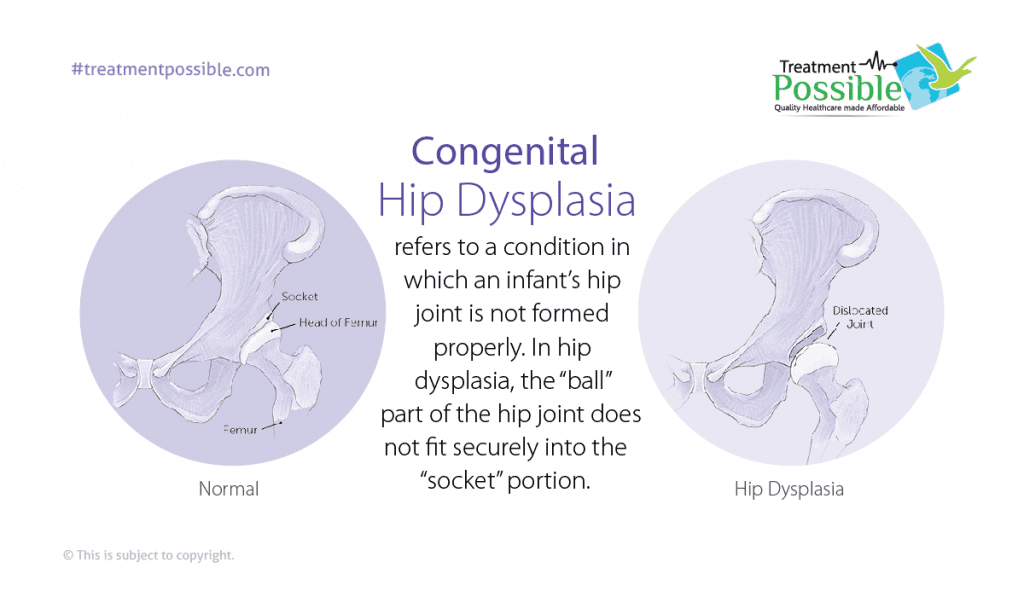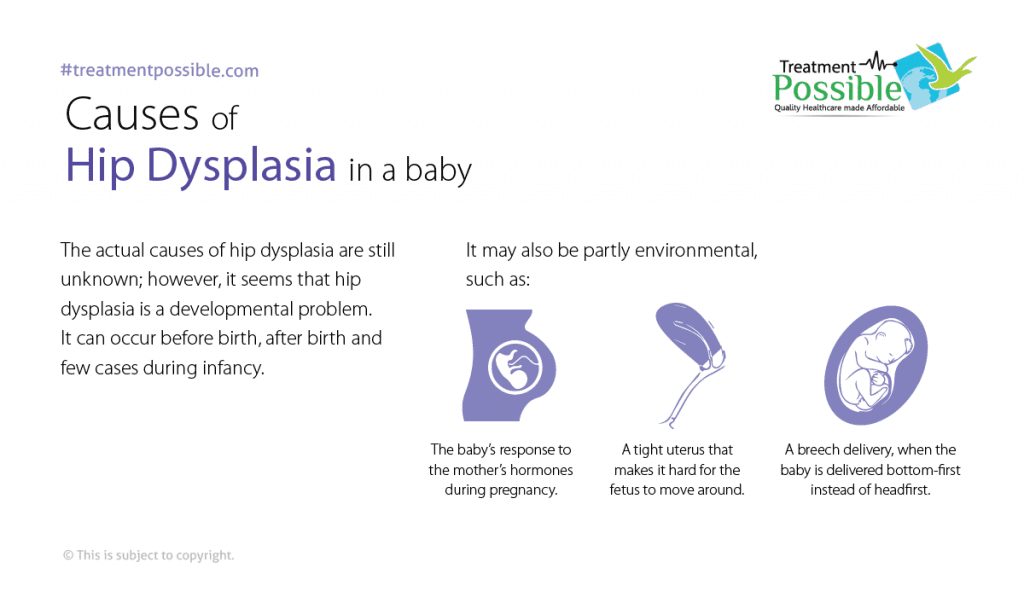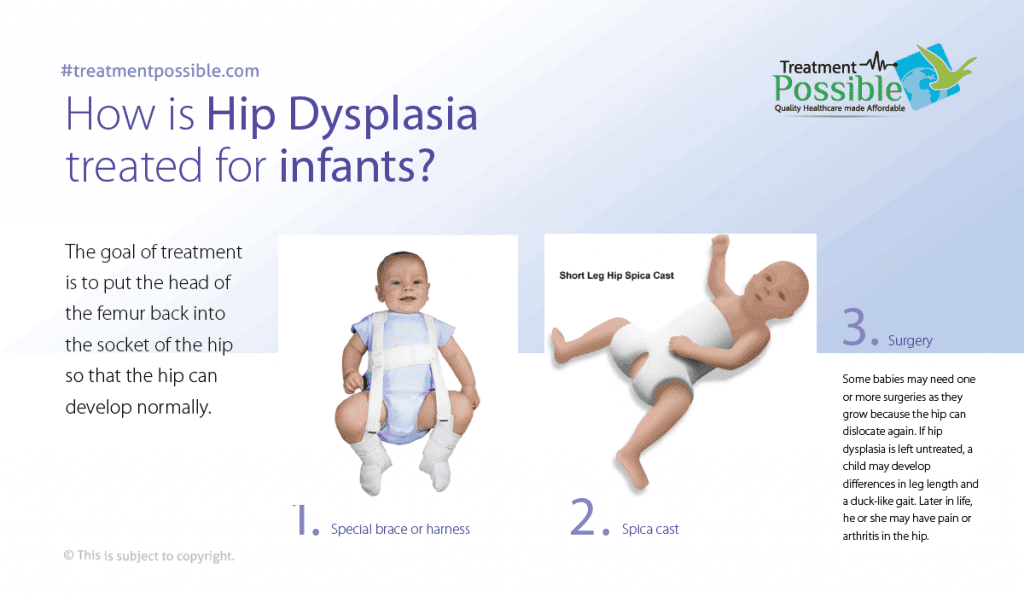What is Congenital Hip Dysplasia?
Hip dysplasia refers to a condition in which an infant’s hip joint is not formed properly. In hip dysplasia, the “ball” part of the hip joint does not fit securely into the “socket” portion. This can lead to problems walking. Hip dysplasia in children means the ball and socket joint of the hip is not aligned correctly and it may affect one or both of the hips. Hip dysplasia is found in babies and young children. It is more common in girls than in boys. The most common method to identify hip dysplasia is a physical examination of the hips, checking for any instability or looseness. The goal of treatment is to maintain the contact of the “ball” part of the hip joint to fit the “socket” portion securely which will decrease pain and preserve the patient’s native hip.
If hip dysplasia is identified in the first few months of life, it can be treated non-surgically, but a few cases may require surgery. When detected in early infancy, a non-surgical positioning device called a Pavlik harness may be used to keep a child’s hips flexed and abducted, correcting the alignment issues. Babies typically wear the harness for two to three months or until the hip issues are corrected. Afterwards, we follow patients for several years to make sure the child’s hips continue to function correctly.

What Causes Hip Dysplasia in Infants?
The actual causes of hip dysplasia are still unknown; however, it seems that hip dysplasia is a developmental problem. It can occur before birth, after birth and few cases during infancy. It may also be partly environmental, such as:
- The baby’s response to the mother’s hormones during pregnancy.
- A tight uterus that makes it hard for the fetus to move around.
- A breech delivery, when the baby is delivered bottom-first instead of headfirst.

Which Children are at Risk for Hip Dysplasia?
First-born babies are at higher risk because the uterus is small and there is limited room for the baby to move. That may affect how the hip develops. Other risk factors are:
- Other orthopedic problems, such as clubfoot
- It is more common in girls than in boys.
- A family history of hip dysplasia
- Being the first-born child
- Babies who are born in the breech position (head up and feet down)
- very flexible ligaments
What are the Symptoms of Hip Dysplasia in a Baby?
The pain may start mild, but it can increase in severity and frequency over time. The pain associated with hip dysplasia is due to an abnormal amount of pressure placed on the rim of the socket. This pressure on the hip socket rim can lead to cartilage damage and eventually arthritis of the hip joint. The following are the common symptoms, they include:
- The leg appears shorter on the side of the dislocated hip
- The leg on the side of the dislocated hip can turn outward
- The folds in the skin of the thigh or buttocks may appear uneven
- The space between the legs may look wider than normal
- Pain in the groin, side or back of hip joint
- Reduced range of movement in the hip joint
- Clicking or popping of the hip
Want more clarification about medical expense & treatment plan?
Plan for hip dysplasia Surgery In India
Get a Free Doctor's OpinionWhatapp UsHow is Hip Dysplasia Diagnosed in a Child?
Hip dysplasia is sometimes noted at birth. Your doctor may screen newborn babies in the hospital for this hip problem before they go home. But hip dysplasia may not be discovered until later check-ups. Your baby may also need these tests:
- X-rays. This test creates images of internal tissues, bones, and organs.
- Ultrasound (sonography). This test uses high-frequency sound waves and a computer to create images of the blood vessels, tissues, and organs. It is used to view internal organs as they function and to assess blood flow through various vessels.
How is Hip Dysplasia Treated in a Child?
There are several ways to treat hip dysplasia. In mild cases of hip dysplasia, conservative therapy with medication and physical therapy may be the first step in treatment. If conservative therapy does not provide pain relief, then you and your doctor can think of surgical intervention.
- Medication – Oral pain medications can be taken to help relieve the pain and decrease inflammation in the hip. Although medication can help, it is only temporary, and cannot correct hip dysplasia.
- Physical therapy – physical therapy can help improve the symptoms of hip pain secondary to hip dysplasia. This can help decrease the pain caused by hip dysplasia, but it will not correct the lack of coverage of the hip socket.
- Injections – An injection with a combination of an anesthetic (numbing medication) and a corticoid steroid may be recommended to alleviate the pain and inflammation surrounding the hip joint. A hip injection can also be ordered to determine that hip pain is coming from the hip joint.
- Surgery – One of the treatment options for hip dysplasia in children aged 12 or older is a procedure called periacetabular osteotomy (PAO). This orthopedic surgery involves opening up the pelvis and carefully making 4 cuts in the pelvis bone to rotate the acetabulum. Goals of the surgery are to reorient the acetabulum to provide better coverage of the femoral head and to lessen the abnormal forces on the rim of the acetabulum.
A patient’s pain can be alleviated once the amount of pressure that is placed on the acetabular rim is minimized. Another goal of this surgery is to preserve the hip joint and decrease the chances of the patient developing arthritis.
Request a Free Estimate

- Travel to India for Affordable and Advanced Healthcare
How is Hip Dysplasia Treated for Infants?
Treatment depends on your baby’s symptoms, age, and general health. It also depends on the severity of the condition. The goal of treatment is to put the head of the femur back into the socket of the hip so that the hip can develop normally. Treatment choices vary for babies. They may include:
- A special brace or harness. The Pavlik harness is often used on babies up to 6 months of age to hold the hip in place while allowing the legs to move a little. Your baby’s healthcare provider puts the harness on and periodically checks its fit. The harness may fix the hip dysplasia. But sometimes the hip may still be partly or completely dislocated.
- Casting. If your child still has hip dysplasia, a cast may help. This is called a Spica cast.
- Surgery. If the other methods don’t work, or if hip dysplasia is diagnosed at age 6 months to 2 years, your child may need surgery to realign the hip. Your child will then need to wear a Spica cast for up to 6 months after surgery. This special cast holds the hip in place so that it heals. After the cast is removed, your child needs a special brace or physical therapy exercises to strengthen the muscles around the hip and in the legs.
If hip dysplasia is found early, many babies do well with the Pavlik harness, and if needed, casting. Some babies may need one or more surgeries as they grow because the hip can dislocate again. If hip dysplasia is left untreated, a child may develop differences in leg length and a duck-like gait. Later in life, he or she may have pain or arthritis in the hip.

Summary of Hip Dysplasia in Children:
- Hip dysplasia in children is a health problem of the hip joint. The hip socket is shallow. This allows the head of the femur to dislocate, slipping in and out of the socket.
- Hip dysplasia is present at birth. It may be caused by genetic problems and environmental factors.
- A baby with Hip dysplasia may have one leg that looks shorter than the other.
- Newborns will be screened for Hip dysplasia before they leave the hospital.
- Treatment includes a Pavlik harness, casting, or surgery.
Care at Treatment Possible:
Treatment Possible is associated with Hip Dysplasia Surgeon who are experienced in operating complex cases and ensure the highest success rate. We only work with Best Hospital for Hip Dysplasia Surgery.
Our understanding of the Indian Healthcare market and our valued relation with Best Hospital for Hip Dysplasia Surgery enables us to maintain the cost that are reasonable, affordable and transparent. Hip Dysplasia Surgery Cost in India through Treatment Possible can be 10-20% lower than similar companies in India and 50-60% cheaper than in other countries.
You can also send your medical reports for Hip dysplasia in Infants to care@treatmentpossible.com for free opinions and suggestions from The Best Hip Dysplasia Specialist with the hassle-free setup of post-operative recovery care, medical travel & stay during the Medical treatment. No matter what the health condition, you always get good healthcare options and cost advantage from Treatment Possible.
Our Services
From Treatment To Recovery, We Are Always There With You!

Medical Visa Letter
We provide a Medical visa letter for which we require the scanned passport copies of the patient and attendant.

Arrange An Appointment With A Surgeon
We arrange for the appointment with the surgeon, confirm for the hospital room and operation theatre (if required)

Post Surgery Follow Up
We help you to fix your telephonic appointment for future follow-ups

Complimentary Pickup
We arrange for complimentary pickup and drop services from the airport.

All The Necessary Arrangements
We arrange for hospital admission, forex exchange, sim card and local assistance

No Need To Worry About Essential Expenses!
We help in sorting out the hospital bill, return ticket, medicines and other essential purchases.
